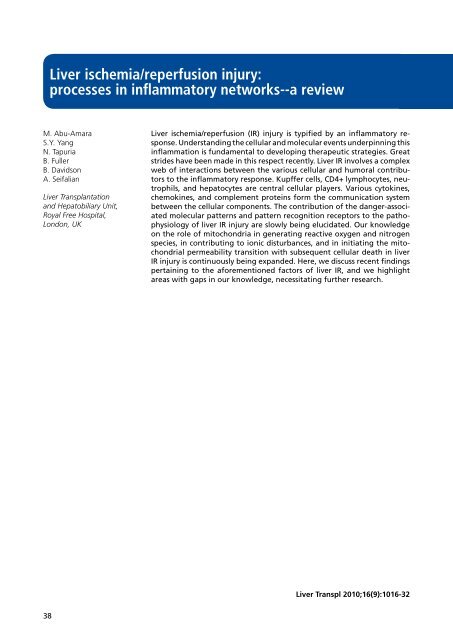AggiornAmenti in riAnimAzione e terApiA intensivA - Pacini Editore
AggiornAmenti in riAnimAzione e terApiA intensivA - Pacini Editore
AggiornAmenti in riAnimAzione e terApiA intensivA - Pacini Editore
You also want an ePaper? Increase the reach of your titles
YUMPU automatically turns print PDFs into web optimized ePapers that Google loves.
38<br />
Liver ischemia/reperfusion <strong>in</strong>jury:<br />
processes <strong>in</strong> <strong>in</strong>flammatory networks--a review<br />
M. Abu-Amara<br />
S.Y. Yang<br />
N. Tapuria<br />
B. Fuller<br />
B. Davidson<br />
A. Seifalian<br />
Liver Transplantation<br />
and Hepatobiliary Unit,<br />
Royal Free Hospital,<br />
London, UK<br />
Liver ischemia/reperfusion (IR) <strong>in</strong>jury is typified by an <strong>in</strong>flammatory response.<br />
Understand<strong>in</strong>g the cellular and molecular events underp<strong>in</strong>n<strong>in</strong>g this<br />
<strong>in</strong>flammation is fundamental to develop<strong>in</strong>g therapeutic strategies. Great<br />
strides have been made <strong>in</strong> this respect recently. Liver IR <strong>in</strong>volves a complex<br />
web of <strong>in</strong>teractions between the various cellular and humoral contributors<br />
to the <strong>in</strong>flammatory response. Kupffer cells, CD4+ lymphocytes, neutrophils,<br />
and hepatocytes are central cellular players. Various cytok<strong>in</strong>es,<br />
chemok<strong>in</strong>es, and complement prote<strong>in</strong>s form the communication system<br />
between the cellular components. The contribution of the danger-associated<br />
molecular patterns and pattern recognition receptors to the pathophysiology<br />
of liver IR <strong>in</strong>jury are slowly be<strong>in</strong>g elucidated. Our knowledge<br />
on the role of mitochondria <strong>in</strong> generat<strong>in</strong>g reactive oxygen and nitrogen<br />
species, <strong>in</strong> contribut<strong>in</strong>g to ionic disturbances, and <strong>in</strong> <strong>in</strong>itiat<strong>in</strong>g the mitochondrial<br />
permeability transition with subsequent cellular death <strong>in</strong> liver<br />
IR <strong>in</strong>jury is cont<strong>in</strong>uously be<strong>in</strong>g expanded. Here, we discuss recent f<strong>in</strong>d<strong>in</strong>gs<br />
perta<strong>in</strong><strong>in</strong>g to the aforementioned factors of liver IR, and we highlight<br />
areas with gaps <strong>in</strong> our knowledge, necessitat<strong>in</strong>g further research.<br />
Liver Transpl 2010;16(9):1016-32







